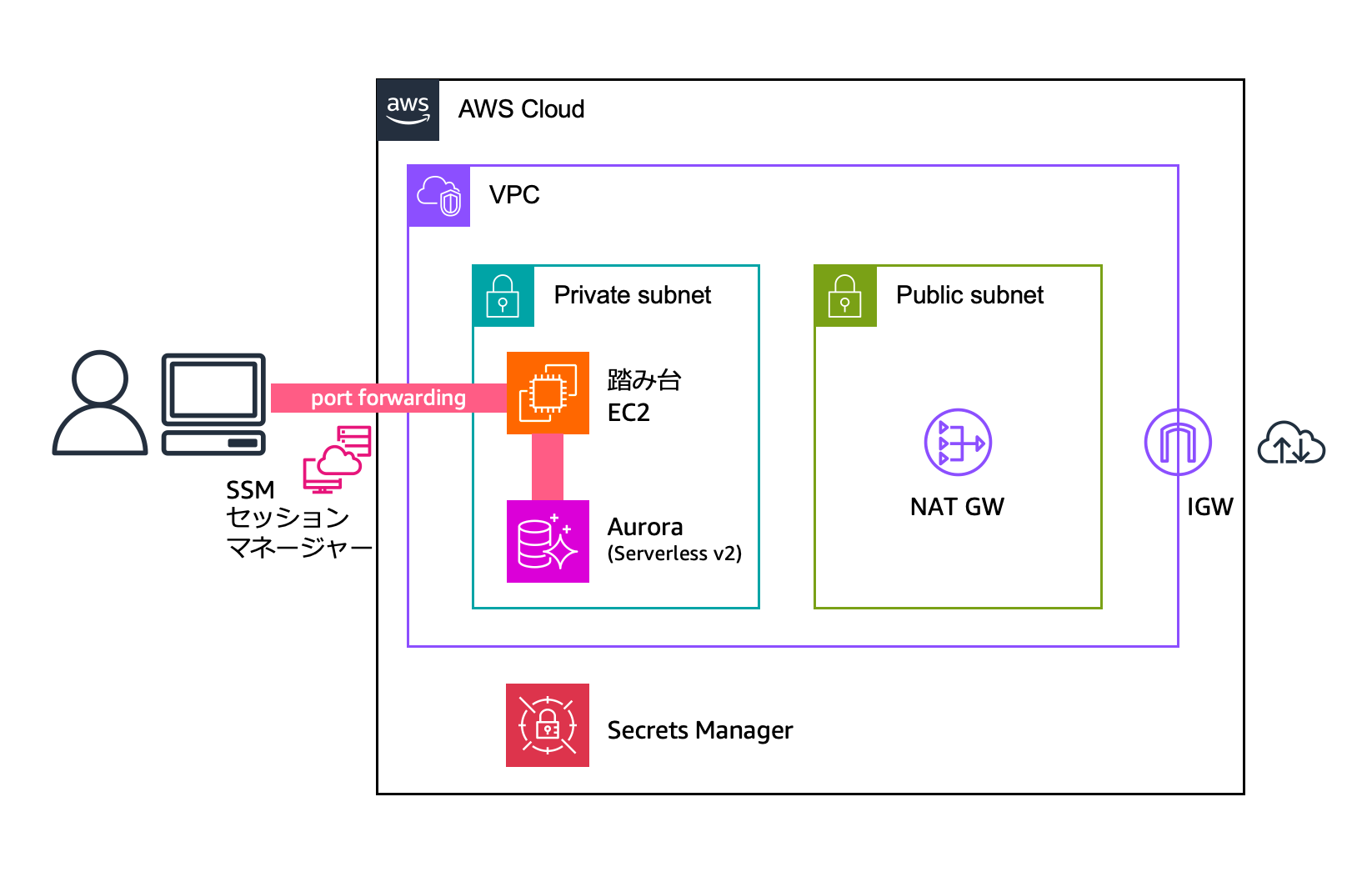概要
- Aurora PostgreSQL の何らかの検証を実施する際、サンプルデータが入っている DB と、 DB に繋がるための踏み台をサクッと用意したいケースがある
- それらをサクっと構築できる CDK Construct (TypeScript) を作った
はじめに
Aurora PostgreSQL (あるいはもっと普遍的な DB) の検証環境がサクっと欲しいこと、ありますよね?
その際に、サンプル DB も入っていてほしいし、ローカルの DB クライアントからサクっと繋げるようにもしたいですよね?
これを実現する CDK のコンストラクトを作りました。1 ファイルで収めているので、簡単に取り込んで使うことができます。中身には以下が含まれています。
- Aurora PostgreSQL Serverless v2
- SSM Session Manager で繋ぐ踏み台 EC2 インスタンス
- PostgreSQL Tutorial に含まれているサンプルデータベース(dvdrental)の自動セットアップ
- 必要なネットワークリソース一式
使い方
1. コンストラクトの準備
プロジェクトの lib/constructs ディレクトリに sample-db-env.ts を作成し、以下のコードをコピーします (長いので折りたたんでいます):
lib/constructs/sample-db-en.tsv (クリックして全文表示)
import * as cdk from 'aws-cdk-lib';
import * as ec2 from 'aws-cdk-lib/aws-ec2';
import * as iam from 'aws-cdk-lib/aws-iam';
import * as rds from 'aws-cdk-lib/aws-rds';
import { Construct } from 'constructs';
export interface SampleDbEnvProps {
/**
* VPCで使用するアベイラビリティゾーンの最大数
* @default 2
*/
maxAzs?: number;
/**
* VPCで使用するNAT Gatewayの数
* @default 1
*/
natGateways?: number;
/**
* 踏み台サーバーのインスタンスタイプ
* @default t3.small
*/
instanceType?: ec2.InstanceType;
/**
* リソースの削除ポリシー
* @default RemovalPolicy.DESTROY
*/
removalPolicy?: cdk.RemovalPolicy;
/**
* Serverless v2の最小キャパシティユニット
* @default 0.5
*/
minCapacity?: number;
/**
* Serverless v2の最大キャパシティユニット
* @default 1
*/
maxCapacity?: number;
/**
* Postgresのバージョン
* @default VER_16_6
*/
engineVersion?: rds.AuroraPostgresEngineVersion;
}
export class SampleDbEnv extends Construct {
public readonly vpc: ec2.Vpc;
public readonly cluster: rds.DatabaseCluster;
public readonly bastionInstance: ec2.Instance;
public readonly bastionSecurityGroup: ec2.SecurityGroup;
public readonly databaseSecurityGroup: ec2.SecurityGroup;
constructor(scope: Construct, id: string, props: SampleDbEnvProps = {}) {
super(scope, id);
// デフォルト値の設定
const {
maxAzs = 2,
natGateways = 1,
instanceType = ec2.InstanceType.of(ec2.InstanceClass.T3, ec2.InstanceSize.SMALL),
removalPolicy = cdk.RemovalPolicy.DESTROY,
minCapacity = 0.5,
maxCapacity = 1,
engineVersion = rds.AuroraPostgresEngineVersion.VER_16_6,
} = props;
// VPCの作成
this.vpc = new ec2.Vpc(this, 'VPC', {
maxAzs,
natGateways,
subnetConfiguration: [
{
cidrMask: 24,
name: 'Public',
subnetType: ec2.SubnetType.PUBLIC,
},
{
cidrMask: 24,
name: 'Private',
subnetType: ec2.SubnetType.PRIVATE_WITH_EGRESS,
},
],
});
// EC2のセキュリティグループ
this.bastionSecurityGroup = new ec2.SecurityGroup(this, 'BastionSecurityGroup', {
vpc: this.vpc,
description: 'Security group for bastion EC2 instance',
allowAllOutbound: true,
});
// Auroraのセキュリティグループ
this.databaseSecurityGroup = new ec2.SecurityGroup(this, 'DatabaseSecurityGroup', {
vpc: this.vpc,
description: 'Security group for Aurora PostgreSQL',
allowAllOutbound: true,
});
// EC2からAuroraへの通信を許可
this.databaseSecurityGroup.addIngressRule(
this.bastionSecurityGroup,
ec2.Port.tcp(5432),
'Allow PostgreSQL access from EC2'
);
// EC2のIAMロール
const ec2Role = new iam.Role(this, 'EC2Role', {
assumedBy: new iam.ServicePrincipal('ec2.amazonaws.com'),
});
// SSM管理ポリシーを追加
ec2Role.addManagedPolicy(
iam.ManagedPolicy.fromAwsManagedPolicyName('AmazonSSMManagedInstanceCore')
);
// Aurora PostgreSQL Serverless v2 クラスターの作成
this.cluster = new rds.DatabaseCluster(this, 'AuroraCluster', {
engine: rds.DatabaseClusterEngine.auroraPostgres({
version: engineVersion,
}),
serverlessV2MinCapacity: minCapacity,
serverlessV2MaxCapacity: maxCapacity,
vpc: this.vpc,
writer: rds.ClusterInstance.serverlessV2("Writer"),
vpcSubnets: {
subnetType: ec2.SubnetType.PRIVATE_WITH_EGRESS,
},
securityGroups: [this.databaseSecurityGroup],
removalPolicy,
});
this.cluster.secret?.grantRead(ec2Role);
const userData = ec2.UserData.forLinux();
// 第1段階:必要なツールのインストールと初期設定
userData.addCommands(
'dnf install postgresql16 jq -y',
'echo "Setting up environment variables..."',
`echo ${this.cluster.secret?.secretName}`,
`aws secretsmanager get-secret-value --secret-id ${this.cluster.secret?.secretName} | jq .SecretString > secrets.json`,
'PGHOST=`cat secrets.json | jq "fromjson | .host" -r`',
'PGUSER=`cat secrets.json | jq "fromjson | .username" -r`',
'PGPASSWORD=`cat secrets.json | jq "fromjson | .password" -r`',
'echo "export PGHOST=$PGHOST" >> ~/.bash_profile',
'echo "export PGUSER=$PGUSER" >> ~/.bash_profile',
'echo "export PGPASSWORD=$PGPASSWORD" >> ~/.bash_profile',
'source ~/.bash_profile',
);
// 第2段階:タイムアウト付きでRDSの準備完了を確認してからサンプルDBを読み込む
userData.addCommands(
'echo "Waiting for RDS to be available (timeout: 20 minutes)..."',
'start_time=$(date +%s)',
'timeout=1200 # 20 minutes in seconds',
'while true; do',
' if PGPASSWORD=$PGPASSWORD psql -h $PGHOST -U $PGUSER -d postgres -c "SELECT 1" > /dev/null 2>&1; then',
' echo "Database connection successful!"',
' break',
' fi',
' current_time=$(date +%s)',
' elapsed=$((current_time - start_time))',
' if [ $elapsed -ge $timeout ]; then',
' echo "Timeout waiting for database to be ready after 20 minutes"',
' exit 1',
' fi',
' echo "Waiting for database to be ready... ($(($timeout - $elapsed)) seconds remaining)"',
' sleep 10',
'done',
'echo "Proceeding with sample data import..."',
'curl -O https://www.postgresqltutorial.com/wp-content/uploads/2019/05/dvdrental.zip',
'unzip ./dvdrental.zip',
'createdb dvdrental',
'pg_restore -d dvdrental ./dvdrental.tar',
);
// EC2インスタンスの作成
this.bastionInstance = new ec2.Instance(this, 'BastionInstance', {
vpc: this.vpc,
vpcSubnets: {
subnetType: ec2.SubnetType.PRIVATE_WITH_EGRESS,
},
instanceType,
machineImage: new ec2.AmazonLinuxImage({
generation: ec2.AmazonLinuxGeneration.AMAZON_LINUX_2023,
}),
securityGroup: this.bastionSecurityGroup,
role: ec2Role,
userData,
});
// 出力の追加
new cdk.CfnOutput(this, 'EC2InstanceId', {
value: this.bastionInstance.instanceId,
});
new cdk.CfnOutput(this, 'AuroraEndpoint', {
value: this.cluster.clusterEndpoint.hostname,
});
const command = `aws ssm start-session --target ${this.bastionInstance.instanceId} \
--document-name AWS-StartPortForwardingSessionToRemoteHost \
--region ${cdk.Stack.of(this).region} \
--parameters '{ \
"host": ["${this.cluster.clusterEndpoint.hostname}"], \
"portNumber": ["5432"], \
"localPortNumber": ["5432"] \
}'`;
new cdk.CfnOutput(this, 'PortForwardingCommand', {
value: command,
});
new cdk.CfnOutput(this, 'GetPasswordCommand', {
value: `aws secretsmanager get-secret-value --secret-id ${this.cluster.secret?.secretName} | jq ".SecretString | fromjson | .password" -r`,
});
new cdk.CfnOutput(this, 'AuroraSecretName', {
value: this.cluster.secret?.secretName || '',
});
// SSM Session Managerを使用したリモートログインコマンド
new cdk.CfnOutput(this, 'SSMLoginCommand', {
value: `aws ssm start-session --target ${this.bastionInstance.instanceId} --region ${cdk.Stack.of(this).region}`
});
}
}
2. CDK スタックでの使用
メインのスタックファイルで以下のように使用します:
import * as cdk from 'aws-cdk-lib';
import { Construct } from 'constructs';
import { SampleDbEnv } from './constructs/sample-db-env';
export class MyStack extends cdk.Stack {
constructor(scope: Construct, id: string, props?: cdk.StackProps) {
super(scope, id, props);
// デフォルト設定で作成
const dbEnv = new SampleDbEnv(this, 'SampleDbEnv');
// または、カスタム設定で作成
const customDbEnv = new SampleDbEnv(this, 'CustomDbEnv', {
maxAzs: 3,
natGateways: 2,
instanceType: ec2.InstanceType.of(ec2.InstanceClass.T3, ec2.InstanceSize.MEDIUM),
minCapacity: 1,
maxCapacity: 4,
engineVersion: rds.AuroraPostgresEngineVersion.VER_15_4,
});
}
}
3. デプロイ
cdk deploy 実行後、以下の出力が表示されます:
Outputs:
MyStack.SampleDbEnvEC2InstanceId = i-0123456789abcdef0
MyStack.SampleDbEnvAuroraEndpoint = sample-cluster.cluster-xxxxx.region.rds.amazonaws.com
MyStack.SampleDbEnvPortForwardingCommand = aws ssm start-session --target i-0123456789abcdef0 --document-name AWS-StartPortForwardingSessionToRemoteHost --region ap-northeast-1 --parameters '{"host": "............" // 省略
MyStack.SampleDbEnvGetPasswordCommand = aws secretsmanager get-secret-value ...
MyStack.SampleDbEnvAuroraSecretName = MyStack-SampleDbEnvAuroraClusterSecret...
MyStack.SampleDbEnvSSMLoginCommand = aws ssm start-session --target i-0123456789abcdef0 ...
4. データベースへの接続
踏み台にログインして使う場合
まず、EC2 インスタンスにログインしましょう。
# 出力された SSMLoginCommand を実行
aws ssm start-session --target i-0123456789abcdef0 --region ap-northeast-1
ログイン先の EC2 で root ユーザに切り替えると、 psql コマンドを叩くだけで接続できます。
(環境変数に接続情報が設定されています)
# root ユーザに切替
sudo su -
# 環境変数が既に設定されているため、そのまま psql コマンドが使えます
psql -d dvdrental
ローカル環境から接続する場合
まず、パスワードを取得します。
# 出力された GetPasswordCommand を実行
aws secretsmanager get-secret-value ...
次に、SSM を使ってポートフォワーディングの設定をします。
# 出力された PortForwardingCommand を実行
aws ssm start-session --target i-0123456789abcdef0 --document-name AWS-StartPortForwardingSessionToRemoteHost --region ap-northeast-1 --parameters '{"host": "............" // 省略
あとは、適当な DB クライアントで localhost:5432 に向かって接続するだけです。
DB 名は dvdrental、ユーザーは postgres、パスワードは先ほど取得したものを使います。
カスタマイズ可能なパラメータ
| パラメータ | 説明 | デフォルト値 |
|---|---|---|
| maxAzs | VPCで使用するAZの数 | 2 |
| natGateways | NAT Gatewayの数 | 1 |
| instanceType | 踏み台サーバーのインスタンスタイプ | t3.small |
| minCapacity | Aurora Serverless v2の最小容量 | 0.5 |
| maxCapacity | Aurora Serverless v2の最大容量 | 1 |
| engineVersion | PostgreSQLのバージョン | VER_16_6 |
| removalPolicy | リソースの削除ポリシー | DESTROY |
注意点
全体的に検証用の構成なので、用法・容量を守ってお使いください。(セキュリティ等)

